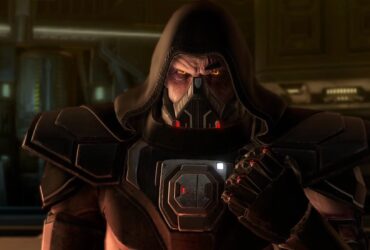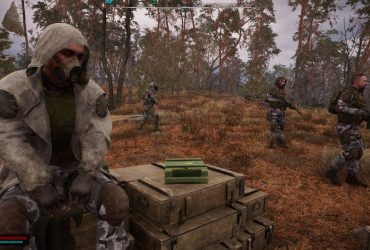A mage killer and a mage walk into a bar, but it’s Dragon Age: The Veilguard, so nothing happens. Lucanis might have the reputation of a cutthroat assassin who hunts down wizards, but in reality, he’s a ‘don’t talk to me until I’ve had my coffee’ millennial with as much bite as a defanged Griffon.
That sums up pretty much every companion in the game. After spending hours with the nauseatingly nice Bellara, the surprisingly friendly and forgiving Neve, and the go-get-’em bundle of joy that is Harding, I was ecstatic to meet a necromancer! Surely, they’ll be a little more rough around the edges? Nope.
Everyone is too nice, too selfless, too heroic. I’d find these against the grain characters endearing if it wasn’t for the fact that nobody has a mean bone in their body. God help me, I’m surrounded by Wylls.
Wyll’s Dynamic With The Rest Of The Party Makes Him Interesting
Often considered the most boring companion in Baldur’s Gate 3, Wyll gets a bad rap. But it’s unsurprising — the moral hero is a boring character archetype by design. Being so willing to save the day at the very start of the journey leaves little room for growth, making it difficult to stay invested in their stories unless you throw a Mizora-shaped spanner in the works or balance it out with a few selfish types.
Baldur’s Gate 3 does this incredibly well with a desperate vampire lusting for power, a racist Shar worshiper who has been deceived and corrupted, and a militaristic githyanki who would happily kill you in your sleep. They stop Wyll’s positivity from being overbearing and bring to life his true character, breaking beneath the surface of that valiant shell to unearth the real Wyll.
It’s a great thread throughout Baldur’s Gate 3, which uses conflicting motives to not only make the companions more interesting, but to make their relationships feel more organic.
Take Shadowheart. Her ‘theft’ of a githyanki artifact and her demeaning comments about the githyanki people immediately drives a wedge between her and Lae’zel, but in unraveling Lae’zels quest by visiting the creche, and by challenging Shadowheart’s dogmatic upbringing, the two grow closer and help each other. There’s value to having conflict, because it allows you to dive deeper into who these people are.
The Veilguard Companions Should Hate Each Other
By contrast, everyone is too chummy in The Veilguard the second they join up, leaving no room for such dynamics and bonds to naturally form.
For one, Lucanis is possessed by a demon, and there’s a surprising lack of tension with Neve, who as a Tevinter mage should be wary of an Abomination. On the other hand, you’d expect Lucanis to be less trustworthy around a mage… being a mage-killer. Then we have Bellara, who as an elf, would likely be uncomfortable around a Tevinter mage given that they historically had elven slaves. Instead, she’s a fan girl.
Taash and Davrin are by far the most interesting companions because, while still quick to join up and make friends, they take time to open up.
The lack of conflict makes everyone feel shallow and devoid of any real personality. Even major story decisions that have huge ramifications on companion’s homes and personal lives are shrugged off. Nobody holds a grudge! I want these people to get mad at me, to storm off, to have these poignant moments of genuine emotion. It makes Rook feel faultless and the bonds between party members meaningless.
Even Wyll has moments of anger at Tav. But in a party full of heroes with a protagonist straddled by a dialogue wheel that makes even the snarky remarks pleasant, that’s just not possible. Nobody is willing to fight back, to argue. It’s textbook toxic positivity: they feel dysfunctional and dismissive because of a refusal to engage with their emotions, but it doesn’t feel like a narrative choice, just a side effect of being so nice.
If Everyone’s Nice, Then Everyone’s Boring
In any other game, I would have loved Bellara. She’s sweet, her excitement is infectious, and her refusal to let even the worst odds wear her down is uplifting like nothing else. But in a party where everybody is that kind and excited, it’s drowned out. What’s bizarre is that Dragon Age had this nailed down in past games. We had party members with an edge, at each other’s throats, growing to become friends long before Baldur’s Gate 3 nailed it. The Veilguard lost sight of that, and I can’t fathom why.
I swear, Rook gets approval for just breathing. I could punch Emmrich in the face and he’d be happy about it.
The game buries a lot of difficult topics to make The Veilguard as inoffensive as possible (my colleague Jack Coleman wrote a brilliant article going into more detail). And a huge side effect of that desire to be palatable is that it’s bland. Nothing sticks out in my mind more than the horrible things my party said to each other while we trudged along, whether it was Alistair telling Morrigan to die in a hole or Anders comparing Fenris to a wild dog.
These moments of tension are why they’ve stuck with us all these years later, because they’re not perfect. They have flaws and feel like real people. It was so easy to bond with them and grow invested in their arcs because they weren’t mindlessly supportive, nodding along like robots. I haven’t felt compelled by a single Veilguard companion yet, and I’m not sure I ever will.

Dragon Age: The Veilguard is the long-awaited fourth game in the fantasy RPG series from BioWare formerly known as Dragon Age: Dreadwolf. A direct sequel to Inquisition, it focuses on red lyrium and Solas, the aforementioned Dread Wolf.
Source link














Leave a Reply